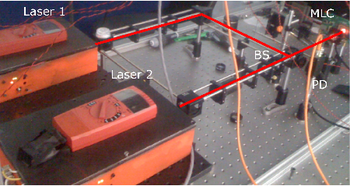Ultrastable heterodyne interferometry using a modulated light camera
Ultrastable heterodyne interferometry using a modulated light camera
PhD student: Rikesh Patel
Project Supervisor: Matt Clark
Project Brief:
Interferometry is used in a wide variety of fields for the instrumentation and analysis of subjects and the environment. Captured widefield interference patterns can be used to determine changes in the optical path length of interfering beams across a 2D area. The heterodyne interferometers use light with different optical frequencies to generate a fringe pattern that is modulated at a frequency equal to the optical frequency difference (beat frequency). A widefield heterodyne system is not straightforward to bring into practice, however, it does offer some benefits such as direct phase interpretation and the suppression of low frequency background light in interferograms.
For this project, a widefield heterodyne interferometer system was developed. A custom prototype modulated light camera (MLC) chip was used to capture both homodyne and heterodyne fringe patterns. The 32x32 pixel camera is capable of continuously demodulating incident modulated light at frequencies between 100 kHz and 17 MHz. With modifications to the system, an ultrastable widefield heterodyne interferometer system was implemented. The intention of this system was to eliminate the contribution of piston phase to a captured interferogram without the need for common path optics. In contrast to the standard heterodyne setup, the reference signal used in the demodulation process was derived from one of the pixels on-board the MLC, rather than from an external source. This new local reference signal tracks the common changes in the temporal phase detected by all the MLC's pixels, eliminating piston phase and substantially reducing the contributions of unwanted vibrations and microphonics from interferograms. As an application of the ultrastable system, a novel interferometer has been developed that captures the widefield fringe patterns generated by interfering two independent light sources, rather than by a single split source. The two separately stabilised HeNe lasers, constructed in the laboratory, produce light with a reasonably stable output frequency. Interfering two of these sources produce a heterodyne interference pattern with an unknown beat frequency. The beat frequency continuously varies because of the variation in the output frequency of each laser, but these stabilised lasers produce a beat frequency that drift by as little as 3 MHz over 30 minutes. As the ultrastable system tracks changes in the temporal phase and instantaneous frequency of an incident fringe pattern, it can be used to track the variations in the modulation frequency generated by the fluctuations in the two separate lasers.


Thesis link: PDF
Publications:
Rikesh Patel, Samuel Achamfuo-Yeboah, Roger Light, Matt Clark - Ultrastable heterodyne interferometer system using a CMOS modulated light camera
- Opt. Express 20(16):17722--17733, Jul 2012
- http://www.opticsexpress.org/abstract.cfm?URI=oe-20-16-17722
BibtexAuthor : Rikesh Patel, Samuel Achamfuo-Yeboah, Roger Light, Matt Clark
Title : Ultrastable heterodyne interferometer system using a CMOS modulated light camera
In : Opt. Express -
Address :
Date : Jul 2012
Rikesh Patel, Samuel Achamfuo-Yeboah, Roger Light, Matt Clark - Widefield heterodyne interferometry using a custom CMOS modulated light camera
- Opt. Express 19(24):24546--24556, Nov 2011
- http://www.opticsexpress.org/abstract.cfm?URI=oe-19-24-24546
BibtexAuthor : Rikesh Patel, Samuel Achamfuo-Yeboah, Roger Light, Matt Clark
Title : Widefield heterodyne interferometry using a custom CMOS modulated light camera
In : Opt. Express -
Address :
Date : Nov 2011